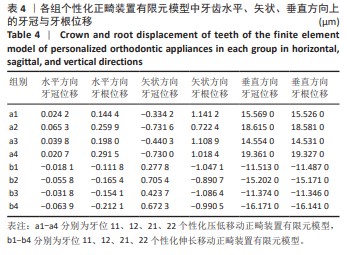[1] BULUT E, GÜÇLÜ ZA. Evaluation of primary teeth affected by dental trauma in patients visiting a university clinic, part 2: dental injury types, treatment strategies, and complications. Clin Oral Investig. 2023;27(2):727-737.
[2] 沈振华,任伟.种植体支抗压低过长后牙在老年对颌牙缺失患者种植修复中的应用[J].口腔材料器械杂志,2022,31(1):73-76.
[3] YAMAGUCHI T, HOSOMICHI K, SHIROTA T, et al. Primary failure of tooth eruption: Etiology and management. Jpn Dent Sci Rev. 2022;58:258-267.
[4] SMIDT A, NAJJAR N, LOUZON Y. The esthetic challenge of a malpositioned peg-shaped lateral incisor and a missing contralateral maxillary tooth: report of a case. Quintessence Int. 2023;54(5):394-399.
[5] 施则安,夏恺,罗良语,等.无托槽隐形矫治器联合微种植体内收并压低上前牙的三维有限元分析[J]. 华西口腔医学杂志,2022,40(5):589-596.
[6] MIYAZAWA K, TAMADA Y, TABUCHI M, et al. Effective approach for improving a gummy smile : Upward movement of the maxillary occlusal plane using midpalatal miniscrews and a modified transpalatal arch. J Orofac Orthop. 2024;85(3):167-180.
[7] AREVALO SS, CHOY R, RICH AP, et al. Relationship of Lower Lingual Arch Appliance Use and Impaction of Second Molars: A Retrospective Study. Pediatr Dent. 2020;42(2):123-125.
[8] GRISWOLD O, LI C, ORR JC, et al. Lip Bumper Therapy Does Not Influence the Sagittal Mandibular Incisor Position in a Retrospective CBCT Study. J Clin Med. 2022;11(20):6032.
[9] LEE HJ, CHOI DS, JANG I, et al. Comparison of facemask therapy effects using skeletal and tooth-borne anchorage. Angle Orthod. 2022;92(3):307-314.
[10] 徐静,胡敏.正畸微种植体定位方法研究进展[J].口腔医学研究,2023, 39(2):101-104.
[11] 邹帆.微种植支抗钉联合橡皮链压低伸长上颌第一磨牙的效果[J].南昌大学学报(医学版),2022,62(2):72-74.
[12] CHO SM, CHOI SH, SUNG SJ, et al. The effects of alveolar bone loss and miniscrew position on initial tooth displacement during intrusion of the maxillary anterior teeth: Finite element analysis. Korean J Orthod. 2016; 46(5):310-322.
[13] 石菲菲,葛文慧,许来俊.数字化3D打印技术在口腔医学中的临床应用进展[J].山东医药,2023,63(11):104-108.
[14] ELIADES T, PANAYI N, PAPAGEORGIOU SN. From biomimetics to smart materials and 3D technology: Applications in orthodontic bonding, debonding, and appliance design or fabrication. Jpn Dent Sci Rev. 2023;59:403-411.
[15] CHENG Y, GAO J, FANG S, et al. Torque movement of the upper anterior teeth using a clear aligner in cases of extraction: a finite element study. Prog Orthod. 2022;23(1):26.
[16] JIA L, WANG C, WANG C, et al. Efficacy of various multi-layers of orthodontic clear aligners: a simulated study. Comput Methods Biomech Biomed Engin. 2022;25(15):1710-1721.
[17] 郭龙妹,吉利,陈太聪,等.球面托槽和传统托槽作用下口腔黏膜的生物力学研究[J].医用生物力学,2023,38(5):888-893.
[18] LU Y, CHANG S, YE J, et al. Finite Element Analysis of Bone Stress around Micro-Implants of Different Diameters and Lengths with Application of a Single or Composite Torque Force. PloS One. 2015;10(12):e0144744.
[19] 王延庆,沈竞兴,吴海全.3D打印材料应用和研究现状[J].航空材料学报,2016,36(4):89-98.
[20] LI G, LIU W, LIANG L, et al. Preparing Sr-containing nano-structures on micro-structured titanium alloy surface fabricated by additively manufacturing to enhance the anti-inflammation and osteogenesis. Colloids Surf B Biointerfaces. 2022;218:112762.
[21] SUETENKOV D, IVANOV D, DOL A, et al. Construction of Customized Palatal Orthodontic Devices on Skeletal Anchorage Using Biomechanical Modeling. Bioengineering (Basel). 2022;9(1):12.
[22] WANG Y, CHEN J, QIN S, et al. An in vivo evaluation of clear aligners for optimal orthodontic force and movement to determine high-efficacy and periodontal-friendly aligner staging. Heliyon. 2023;9(4):e15317.
[23] HONG K, KIM WH, EGHAN-ACQUAH E, et al. Efficient Design of a Clear Aligner Attachment to Induce Bodily Tooth Movement in Orthodontic Treatment Using Finite Element Analysis. Materials (Basel). 2021;14(17):4926.
[24] YAO S, JIANG W, WANG C, et al. Improvements of tooth movement efficiency and torque control in expanding the arch with clear aligners: a finite element analysis. Front Bioeng Biotechnol. 2023;11:1120535.
[25] 孙志涛,汪钰程,崔玉美,等.正畸力内收前牙对牙槽骨吸收程度不同后牙的影响[J].华西口腔医学杂志,2019,37(3):265-269.
[26] 蔡晋,谢广安,闫雪,等.TC4钛合金超声喷丸强化覆盖率试验与数值分析[J].航空制造技术,2021,64(19):30-36.
[27] ABDULGHANI EA, AL-SOSOWA AA, ALHAMMADI MS, et al. Three-dimensional assessment of the favorability of maxillary posterior teeth intrusion in different skeletal classes limited by the vertical relationship with the maxillary sinus floor. Head Face Med. 2022;18(1):13.
[28] KAMBLE RH, LOHKARE S, HARAREY PV, et al. Stress distribution pattern in a root of maxillary central incisor having various root morphologies: a finite element study. Angle Orthod. 2012;82(5):799-805.
[29] FUJIYAMA K, KERA Y, YUJIN S, et al. Comparison of clinical outcomes between Invisalign and conventional fixed appliance therapies in adult patients with severe deep overbite treated with nonextraction. Am J Orthod Dentofacial Orthop. 2022;161(4):542-547.
[30] WANG P, CHEN J, WANG X, et al. Orthodontic correction of a skeletal Class II malocclusion with severe gummy smile by total intrusion of the maxillary dentition. Am J Orthod Dentofacial Orthop. 2022;162(5):777-792.
[31] BRUHNKE M, BEUER F, BÖSE MWH, et al. Forced orthodontic extrusion to restore extensively damaged anterior and premolar teeth as abutments for single-crown restorations: Up to 5-year results from a pilot clinical study. J Prosthet Dent. 2023;129(1):61-68.
[32] 丁雪,贾莹,刘纯,等.慢性氟中毒SD大鼠正畸牙移动的位移及速率变化[J].中国组织工程研究,2022,26(29):4687-4692.
[33] PETRESCU SMS, ȚUCULINĂ MJ, POPA DL, et al. Modeling and Simulating an Orthodontic System Using Virtual Methods. Diagnostics (Basel). 2022; 12(5):1296.
[34] MOTOYOSHI M, YANO S, TSURUOKA T, et al. Biomechanical effect of abutment on stability of orthodontic mini-implant. A finite element analysis. Clin Oral Implants Res. 2005;16(4):480-485.
[35] WAUTHLE R, VAN DER STOK J, AMIN YAVARI S, et al. Additively manufactured porous tantalum implants. Acta Biomater. 2015;14:217-225.
[36] 张亮,韩泽奎,臧旖欣,等.仿生蛛网孔隙结构3D打印个性化钛网设计及三维有限元分析[J].中国组织工程研究,2023,27(30):4796-4801.
[37] 林正深,熊国平,黄荣彩,等.牙周病的无托槽隐形矫治技术研究进展[J].临床口腔医学杂志,2018,34(3):177-179.
[38] FIELD C, ICHIM I, SWAIN MV, et al. Mechanical responses to orthodontic loading: a 3-dimensional finite element multi-tooth model[J]. Am J Orthod Dentofacial Orthop. 2009;135(2):174-181.
[39] RUDOLPH DJ, WILLES PMG, SAMESHIMA GT. A finite element model of apical force distribution from orthodontic tooth movement. Angle Orthod. 2001;71(2):127-131.
[40] THOTE AM, UDDANWADIKER RV, SHARMA K, et al. Optimum force system for intrusion and extrusion of maxillary central incisor in labial and lingual orthodontics. Comput Biol Med. 2016;69:112-119.
[41] JAIN A, PRASANTHA GS, MATHEW S, et al. Analysis of stress in periodontium associated with orthodontic tooth movement: a three dimensional finite element analysis. Comput Methods Biomech Biomed Engin. 2021;24(16): 1841-1853. |









